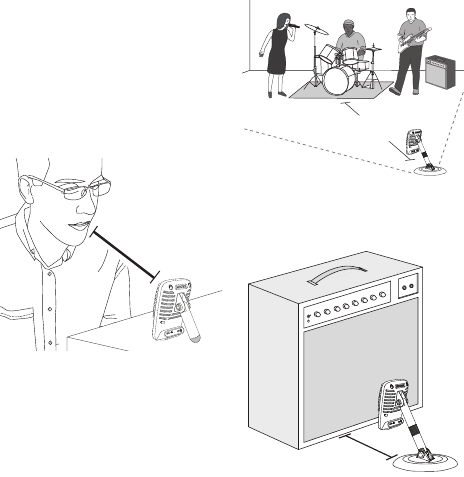
5
6-15 ft
(2-4 m)
For other loud sources, such as an electric guitar
amplifier, aim the microphone at the sound source
from 0-18 inches (0-45 cm) away.
Set the microphone to the Band mode and make
additional gain adjustments if necessary.
0-18 in
(0-45 cm)
Applications
This section suggests microphone placement for
typical use cases. Keep in mind that there are
many effective ways to record a given source.
Experiment with the following microphone
placement and settings to find what works best.
Podcast and Voice Recording
Set the microphone to the Speech mode. Speak
directly into the front of the microphone at a
distance of 2-12 inches (5-30 cm) away. Speaking
closer to the microphone results in more bass
response, similar to voices on a radio broadcast.
Make additional gain adjustments if necessary.
2-12 in
(5-30 cm)
Typical position for speech
Acoustic Instruments and Music
To capture acoustic sources, such as singing,
acoustic guitar, soft percussion, or other musical
instruments, use a close microphone placement.
Aim the microphone directly at the sound source.
For a single source, such as a string instrument or
a vocalist, place the microphone 6 to 12 inches (15
to 30 cm) away. For a small group or a performer
who is singing and playing an instrument
simultaneously, use a distance of 2 to 10 feet
(0.6m to 3 m). Placing the microphone farther
away results in more ambient room sound.
Set the microphone to the Acoustic or Singing
mode and make additional gain adjustments if
necessary.
Bands and Loud Sources
To record a band with drums or amplified
instruments, aim the microphone towards the
group at a distance of 6 to 15 feet (1.8 to 4.6 m).
Placement of the microphone depends on the size
of the room, number of people, and instrument
volume. If possible, walk around the room and
listen to find where it sounds best.
Bypass EQ and Compression (Flat)
To record a signal without any processing, set
the microphone to the Flat mode. This mode is
appropriate for any application when you want to
bypass equalization and compression presets, and
is ideal when applying signal processing to the
recording at a later time.
Additional Tips
Shure offers additional educational publications on
recording techniques for specific instruments and
applications. Visit shure.com for more information.














